Accessibility will have a new face at the Olympic and Paralympic Village in Greater Paris.

Creating Inclusive Multisensory Signage for People with Disabilities
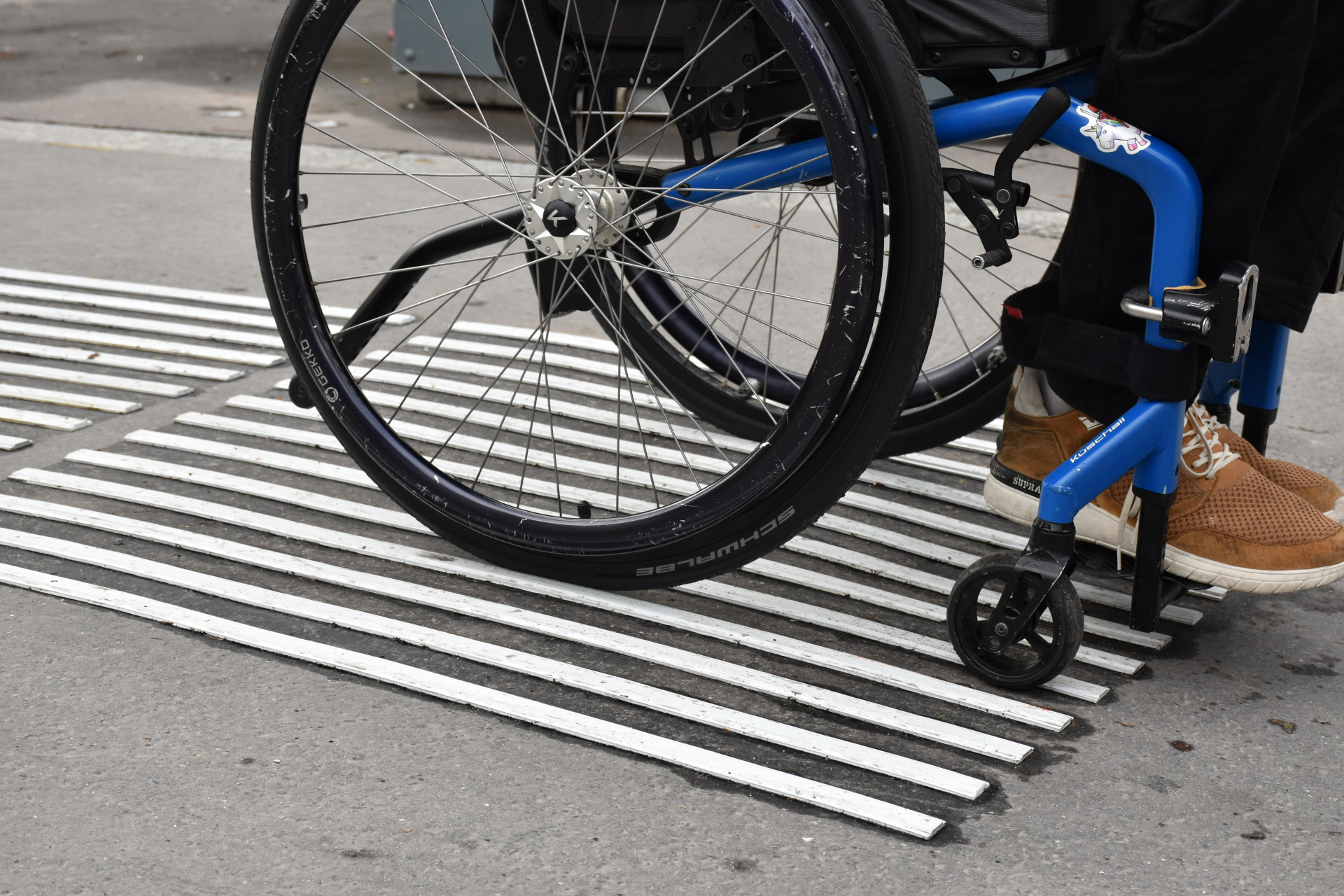
Creating Inclusive Multisensory Signage for People with Disabilities
Vous pensez peut-être qu’une signalétique multisensorielle inclusive relève de l’utopie, qu’il est impossible d’inclure tous les types de handicaps. Eh bien, c’est tout à fait possible. Et c’est ce que nous avons imaginé.
Tout a commencé lorsque SOLIDEO, l’entreprise française en charge de la mise en place des infrastructures d’accueil des athlètes internationaux au Village Olympique et Paralympique, a choisi Okeenea et 5 autres entreprises expertes en accessibilité pour concevoir des solutions de signalétique.
Il est vrai que les Jeux mettent généralement en lumière la ville hôte. L’année prochaine, tous les regards seront tournés vers Paris. C’est l’occasion de repenser l’inclusion.
Quels sont les besoins des personnes en situation de handicap ? Un système de signalisation multisensorielle peut-il être mis en œuvre à l’échelle d’une ville ? Les habitants peuvent-ils l’intégrer dans leur quotidien ?
Signalétique multisensorielle inclusive : l’accessibilité universelle aux portes de Paris
L’année prochaine, Paris accueillera le plus prestigieux événement sportif international. Le défi est de taille pour l’entreprise française SOLIDEO .
Son objectif est de construire des infrastructures durables et de mettre en œuvre des solutions innovantes qui amélioreront la ville de demain.
Cela implique de privilégier l’accessibilité universelle et de prendre en compte les besoins des personnes handicapées, quelles que soient leurs capacités. Car les handicaps sont pluriels.
SOLIDEO a lancé un appel à innovations sur les solutions de signalétique multisensorielle inclusive . Nous avons été sélectionnés parmi cinq autres entreprises expertes en accessibilité pour relever ce défi. Ensemble, nous formons le consortium OMNISENS .
Les solutions de signalétique multisensorielle inclusives que nous avons créées seront déployées après le concours. C’est un atout majeur, car elles permettront aux résidents en situation de handicap de s’orienter dans le quartier.
Toute personne ayant besoin d’une signalétique multisensorielle inclusive pour profiter du quartier et de ses infrastructures sera libre de le faire sans avoir à se soucier de l’accessibilité.
Quelles solutions font partie d’un système de signalétique multisensoriel inclusif ?
Une chose est sûre : développer des solutions inclusives pour accompagner les personnes handicapées n’est pas chose aisée. Car cela implique de prendre en compte tous les types de handicaps et de capacités.
Mais ce qui compte, c’est que ces solutions visent à améliorer l’autonomie des personnes handicapées .
Chemins de guidage directionnels
Les personnes aveugles ou malvoyantes trouvent généralement les chemins de guidage grâce à leur canne blanche ou à leur chien-guide. Elles peuvent sentir les surfaces directionnelles surélevées et suivre elles-mêmes le pavage tactile.
Nous avons développé des chemins de guidage innovants . Ils offrent une autre méthode de détection.
Lorsqu’une personne malvoyante repère ces chemins de guidage avec sa canne blanche, cela crée une vibration. Cela fonctionne en quelque sorte comme un repli.
Le matériau des rails de guidage, l’aluminium, mais surtout leur mode de fixation, sont à l’origine de ce repli. En effet, ces rails sont vissés. Ils ne sont pas complètement collés au sol.
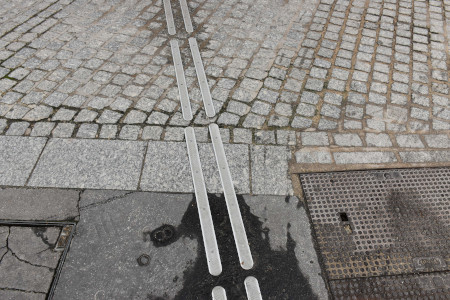
Chemins de guidage croisés
Ces chemins de guidage sont très différents des précédents. Ils sont situés sur le passage piéton.
Leur but est d’aider les piétons aveugles et malvoyants à maintenir leur trajectoire lorsqu’ils traversent la rue.
En réalité, personne ne marche droit. Mais pour une personne malvoyante, traverser peut être plus difficile.
Pavage tactile pour indiquer un point d’intérêt spécifique
En France, ce type de pavé podotactile est très répandu. Son objectif est de guider les personnes malvoyantes depuis le chemin principal vers un point d’intérêt précis.
Il permet à une personne malvoyante de trouver le téléphone d’urgence dans une station de métro ou le distributeur de billets à un arrêt de tramway.
Dans le cadre de la signalisation multisensorielle inclusive que nous avons créée, ce pavage tactile est destiné à aider un piéton aveugle à trouver le passage pour piétons.
Passages piétons accessibles
Il va sans dire qu’il existe bel et bien des signaux piétonniers accessibles dans la zone du village olympique et paralympique pour les athlètes et les résidents ayant une déficience visuelle.
Mais que peut-on faire pour les intersections sans feux de circulation ?
Il peut encore y avoir une signalisation sonore pour permettre aux malvoyants de traverser la rue en toute autonomie.
Nous avons installé des balises sonores de chaque côté d’un passage piéton sans feux de circulation. Tout comme les APS classiques, elles peuvent être activées avec :
⊗ Une télécommande
⊗ MyMoveo, une application smartphone gratuite
Balises sonores aux arrêts de bus
Pour pouvoir aller et venir, les personnes malvoyantes doivent recourir aux transports en commun.
Mais pour monter et descendre du bus, ils doivent d’abord trouver l’arrêt de bus.
C’est une autre utilisation des balises audio. Elles peuvent être installées à tous types de points d’intérêt.
poteaux directionnels
Pour trouver facilement son chemin, nous avons tous besoin d’indications. Nous avons conçu des poteaux directionnels inclusifs pour guider les personnes en situation de handicap :
⊗ Informations textuelles faciles à lire pour les personnes ayant une déficience intellectuelle,
⊗ Contraste visuel pour les malvoyants,
⊗ Police accessible aux personnes atteintes de troubles dys,
⊗ Balises sonores pour les personnes aveugles : les messages permettent de savoir dans quelle direction se trouvent les lieux à proximité.
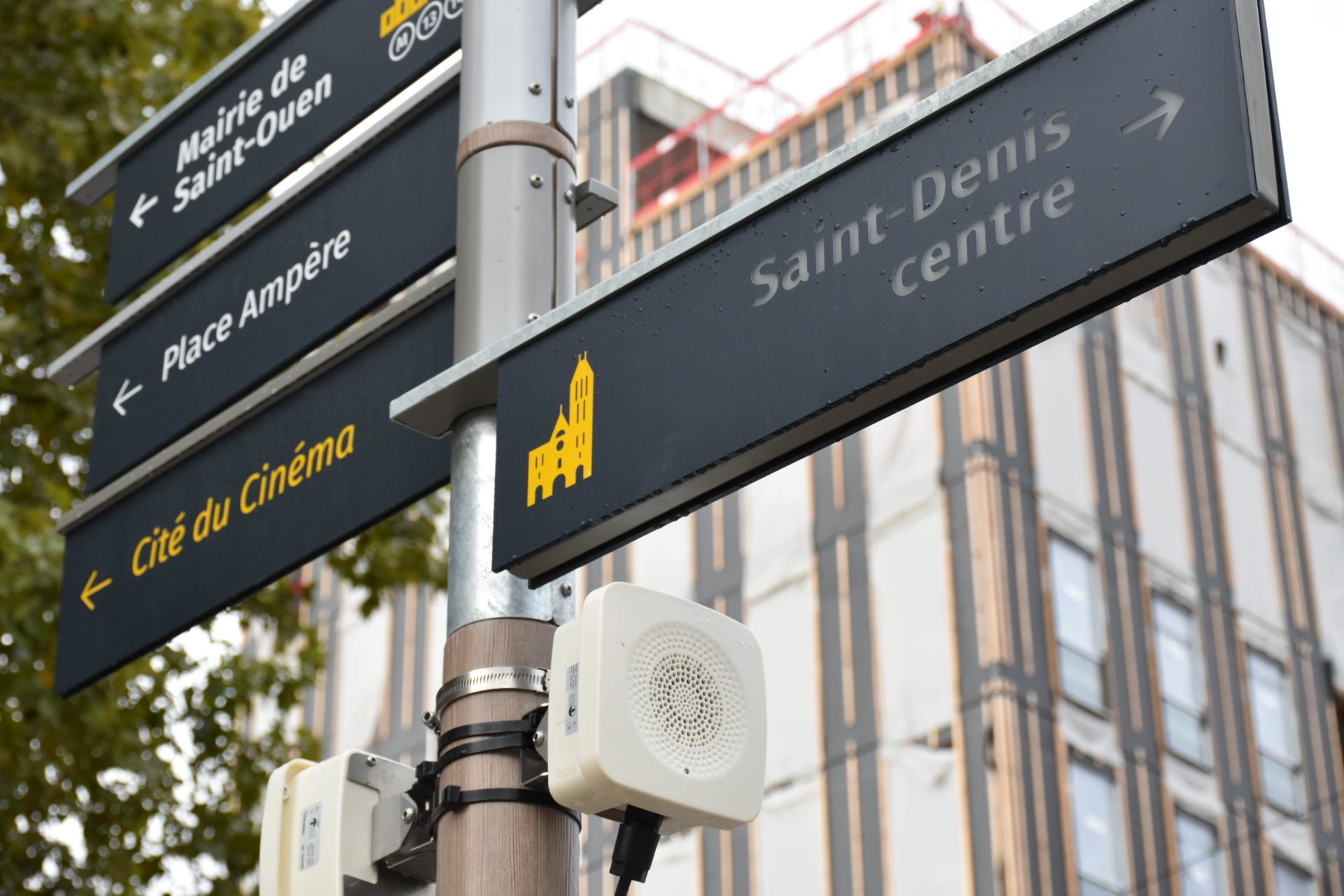
Linear cartography
This is another solution to provide information to all types of users, whether they have disabilities or not.
This equipment has visual, tactile and audio signage. It’s entirely intuitive and inclusive.
Multisensory maps
It’s a similar solution as the linear cartography but the format is different. It makes it easy to use for everybody.
This zooms in on a particular area of the neighborhood.
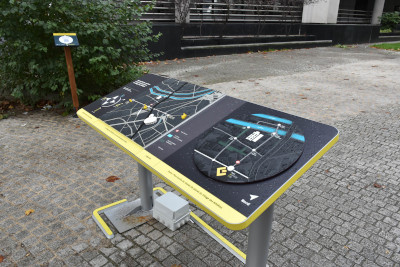
Collecte de données d’accessibilité
Lorsqu’une personne handicapée se déplace dans une ville, elle doit savoir à l’avance ce qui lui est accessible.
C’est là qu’interviennent les données d’accessibilité . Nous nous concentrons sur la collecte de ces données et leur traduction pour les rendre disponibles à chaque type d’utilisateur.
À chaque étape du parcours, les personnes handicapées peuvent savoir comment se rendre dans un lieu et ce qui y est réellement accessible.
En réalité, les données d’accessibilité fournissent davantage de contexte aux utilisateurs. Ce bien numérique représente une opportunité d’améliorer l’accessibilité et l’inclusion.
L’utilisation de solutions numériques nous permet de compléter les équipements d’accessibilité physique installés.
Concevoir une signalétique multisensorielle inclusive avec et pour les personnes en situation de handicap
Nous avons suivi des méthodes spécifiques et organisé deux séries de tests avec des personnes handicapées pour créer les meilleures solutions possibles.
Grâce à ces tests, nous avons pu prendre en compte tous les types de handicap. De plus, ils ont testé toutes les solutions que nous avons conçues. Ainsi, un utilisateur en fauteuil roulant a pu donner son avis sur nos balises audio.
Car l’important est que ces solutions soient utiles et confortables pour tous. Nous les avons constamment adaptées et repensées pour répondre véritablement aux besoins de chacun.
Nous n’aurions pas pu concevoir de solutions multisensorielles inclusives sans le retour des personnes handicapées.
Cette signalisation est fluide et cohérente pour toutes les parties prenantes. Elle contribue à maintenir une chaîne de mobilité fluide .
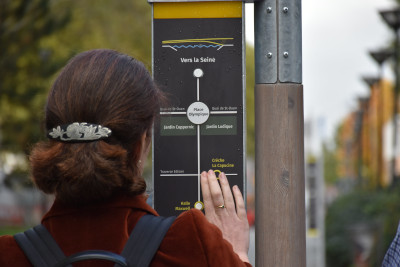
Pourquoi est-il si important de favoriser l’accessibilité et l’inclusion pour tous ?
⊗ Il offre plus d’équité, de liberté et de spontanéité aux personnes handicapées.
⊗ Il ne laisse personne derrière ou à l’écart.
⊗ Il s’agit de « rénover » nos espaces publics en les rendant accessibles.
Certes, l’accessibilité est généralement au centre des préoccupations lors de ces grands événements, mais cela ne signifie pas qu’elle est abandonnée une fois ceux-ci terminés.
Par exemple, Tokyo, au Japon, a amélioré son accessibilité grâce aux Jeux. La vie des habitants handicapés s’est ensuite simplifiée, car la ville a conservé ses équipements d’accessibilité.
Jeux olympiques de Tokyo 2020 : mise à jour des équipements d’accessibilité
Qui se cache derrière la création de cette signalétique multisensorielle inclusive ?
Okeenea a associé son expertise à celle de cinq autres entreprises. Grâce à OMNISENS, les personnes en situation de handicap bénéficieront de solutions parfaitement adaptées à leurs besoins.
Nous sommes fiers de faire de l’inclusion une réalité pour eux et pour d’autres personnes handicapées qui profiteront de nos solutions de signalisation multisensorielle inclusives une fois le concours terminé.
Okeenea
Okeenea est le leader de l’accessibilité en France. Depuis l’invention de la signalisation piétonne accessible, l’entreprise s’engage à améliorer le quotidien des personnes en situation de handicap grâce à des solutions d’accessibilité innovantes pour les travaux publics, mais aussi pour les bâtiments.
Studio tactile
Agence de design inclusif , Tactile Studio est un leader dans la création d’expériences accessibles aux visiteurs pour les institutions culturelles du monde entier. Elle conçoit et produit des visites multisensorielles et hybrides depuis plus de 10 ans.
Atipie
Leur ADN : le design universel. Atipy regroupe 3 agences et un bureau d’études. Ils accompagnent les collectivités, villes, collectivités, associations et institutions dans leurs projets inclusifs.
Empreinte signalétique
Empreinte signalétique développe des projets de signalétique sur mesure, installés en France et à l’international. Ses produits s’adaptent aussi bien aux sites remarquables qu’aux sièges sociaux d’entreprises, et conviennent aux espaces naturels comme aux environnements urbains.
Mengrov
Mengrov est une agence de design communautaire qui co-crée des solutions qui valorisent la force des singularités. Dans une approche alliant design et stratégie, ils développent une approche sensible alliant décryptage des enjeux sociétaux et écoute des attentes.
Polygraphie
Situé à la croisée des signes, des objets et de l’espace, le studio Polygraphik , fondé en 2009 par les designers Sébastien Nicot et Juliette Cheval, est spécialisé dans la conception signalétique. Son rôle est de rendre un lieu compréhensible afin que l’usager puisse s’orienter et se déplacer de manière autonome.
Vous vous demandez peut-être comment nous avons réussi à créer toutes ces différentes solutions de signalisation multisensorielle inclusives.
Gardez ceci à l’esprit :
1. Le handicap a toujours été un moteur d’innovation. Après tout, pour inclure les personnes que la société néglige habituellement, nous devons sortir des sentiers battus.
2. C’est la combinaison de l’accessibilité physique et numérique qui crée des espaces inclusifs.
Vous souhaitez en savoir plus sur les solutions numériques qui améliorent l’accessibilité ? Consultez nos articles :
Les données ouvertes sont essentielles pour favoriser l’accessibilité universelle
Qu’est-ce qu’une expérience phygitale et comment peut-elle améliorer l’accessibilité de votre lieu ?
Publié le 26 mai 2023
media
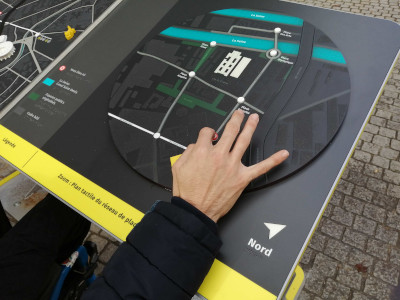
We followed specific methods and organized two series of tests with people with disabilities to create the best possible solutions. (…) Because what matters is that they’re helpful and comfortable for everyone. We kept adjusting and rethinking them to truly meet everybody’s needs.
writer

Carole Martinez
Content Manager & Copywriter
stay updated
Get the latest news about accessibility and the Smart City.
other articles for you

Open Data Is Key to Fostering Universal Accessibility
Open data represents an opportunity for cities to reach universal accessibility. It shows the missing links of the mobility chain.
Our Audio Beacons Guide the Blind and Visually Impaired at the Helsinki Subway
The Helsinky subway improved their audio signage system by installing on demand and remotely activated audio beacons.
7 Good Reasons to Install Audio Beacons at Your Public Transport Network
Audio beacons are an efficient way to provide more autonomy to blind and visually impaired people. They can easily use public transport.

Will Remote Activation Become the Norm for Accessible Pedestrian Signals?
More and more cities like New York have been exploring remote activation to trigger accessible pedestrian signals.
share our article!
more articles

Disability Statistics in the US: Looking Beyond Figures for an Accessible and Inclusive Society
Disability Statistics in the US: Looking Beyond Figures for an Accessible and Inclusive Society Around 61 million adults in the United States live with a disability. Diving into disability statistics in the US will help us know exactly who is concerned and what...
Our Audio Beacons Guide the Blind and Visually Impaired at the Helsinki Subway
Our Audio Beacons Guide the Blind and Visually Impaired at the Helsinki SubwayOur audio beacons equip the new line of the Helsinki subway in Finland. They help blind and visually impaired people locate the points of interest of a station. For users with visual...

Will Remote Activation Become the Norm for Accessible Pedestrian Signals?
Will Remote Activation Become the Norm for Accessible Pedestrian Signals?Without pushbutton, there are no accessible pedestrian signals. That’s how APS work in the U.S. But more and more cities have been exploring remote activation like New York City. The Department...

Hearing Impaired People: a Multitude of Profiles for Different Needs
Hearing Impaired People: a Multitude of Profiles for Different Needs Did you know that hearing impaired people have several profiles and that the way they identify themselves is important? You may be familiar with deaf and hard of hearing people but for each of...
NEVER miss the latest news about the Smart City.
Sign up now for our newsletter.
Unsubscribe in one click. The information collected is confidential and kept safe.
powered by okeenea
The French leading company
on the accessibility market.
For more than 25 years, we have been developing architectural access solutions for buildings and streets. Everyday, we rethink today’s cities to transform them in smart cities accessible to everyone.
By creating solutions ever more tailored to the needs of people with disabilities, we push the limits, constantly improve the urban life and make the cities more enjoyable for the growing majority.


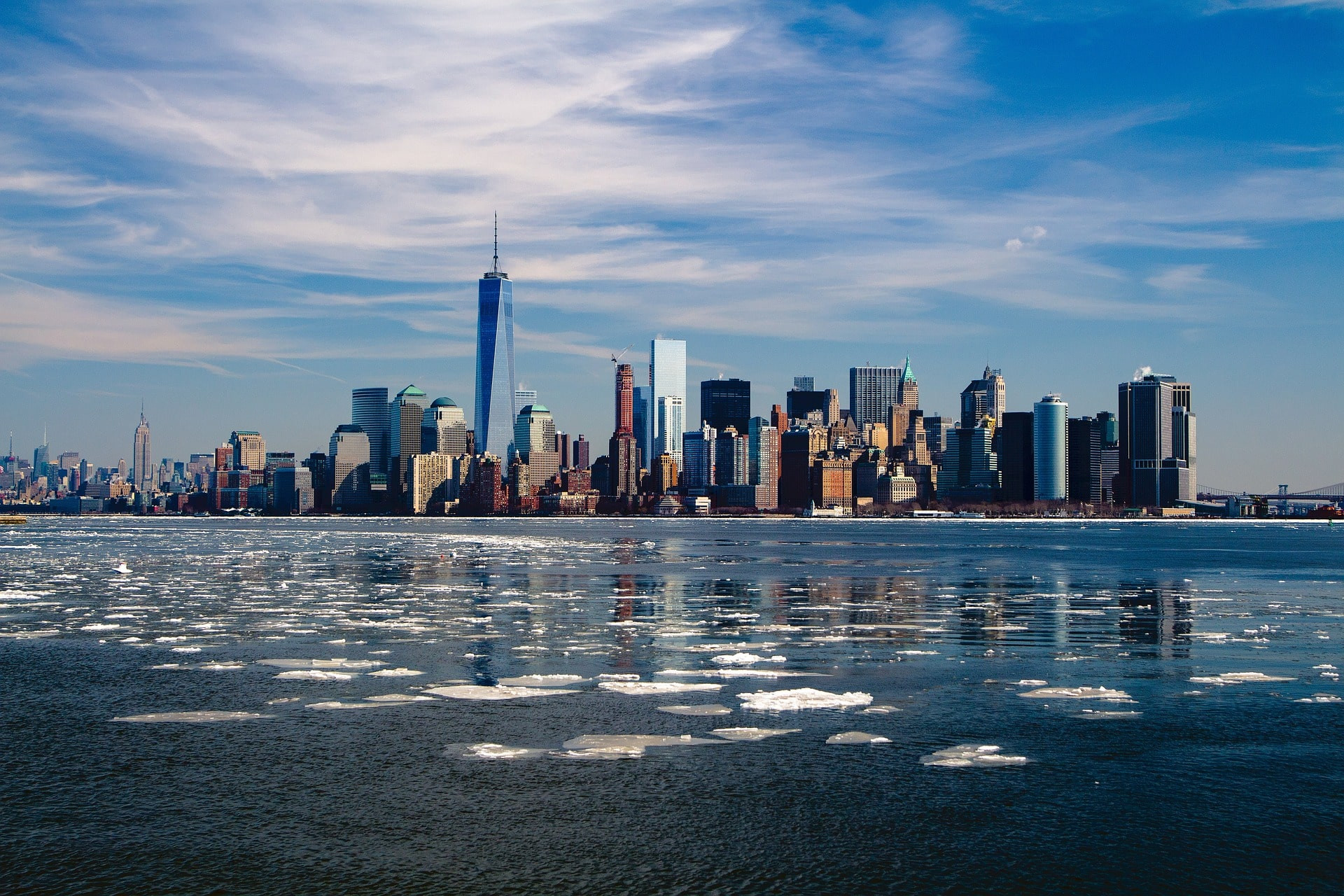
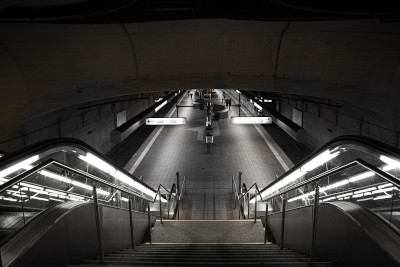

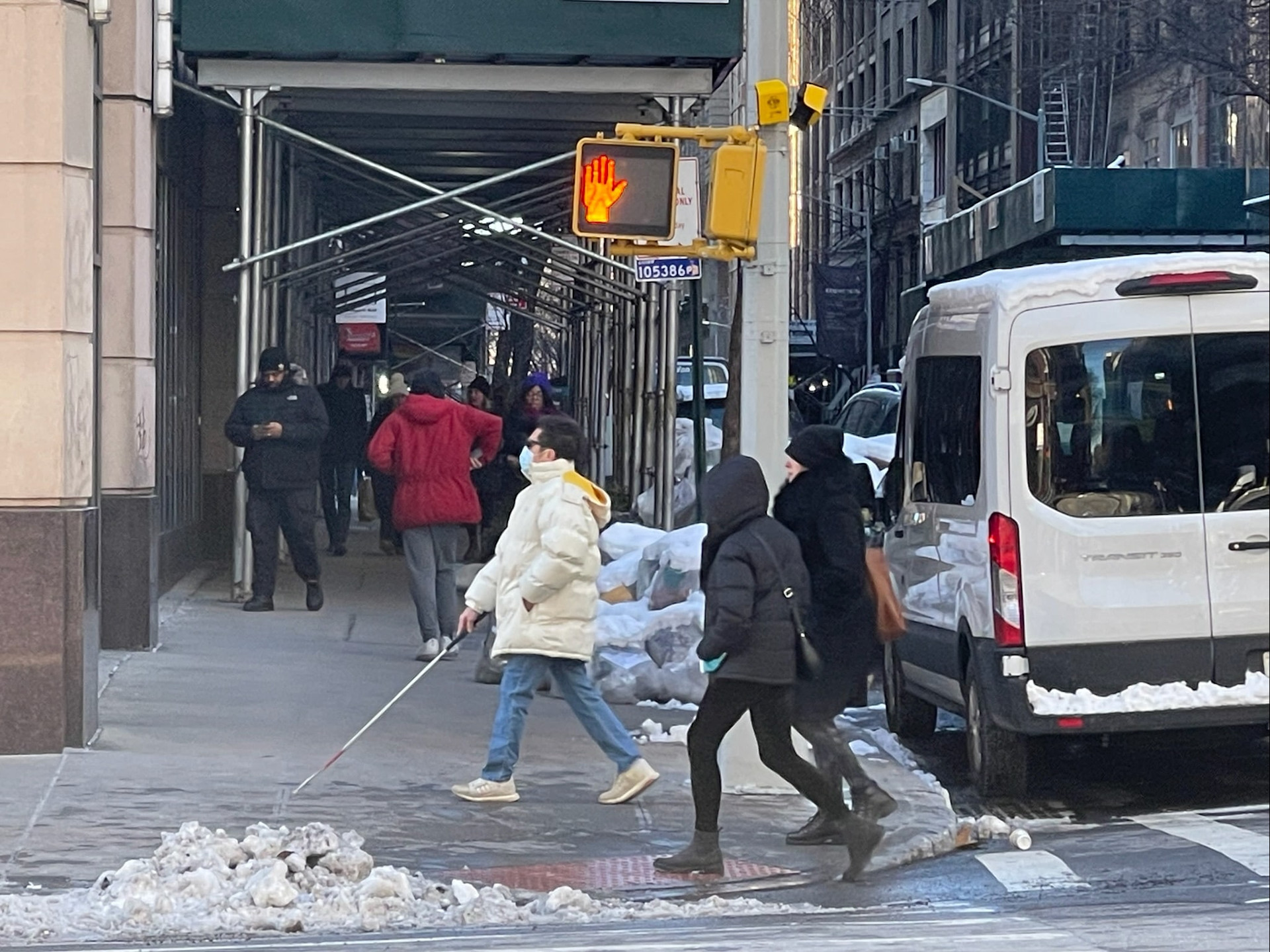
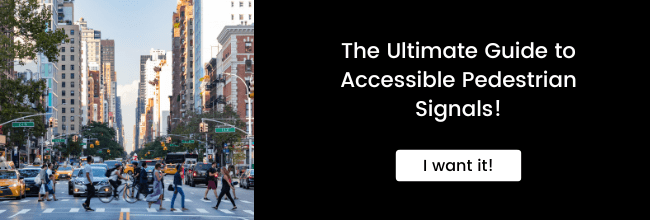
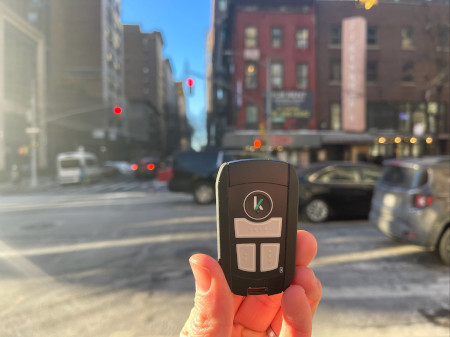
Recent Comments